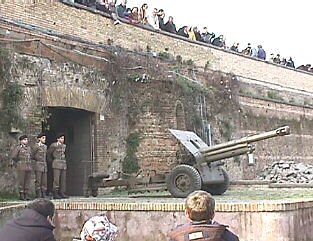|
|
 |
|
Gianicolo. Noon. Be there or be square! |
|
written
by Megan Brewster / 07.01.2004 |
|
|
| |
Hill |
| |
Gianicolo (listed as "Janiculum" in the assignment prompt).
|
| |
|
| |
|
| |
Ancient Image |
| |
Gianicolo is oriented mainly north-south to the west of the Tiber and modern day Rome. In early times, the hill divided the Roman (north) and Etruscan (south) lands, so it was heavily fortified by Ancus Marcius. With the development of gunpowder and its resulting effects on warfare, Urban VIII increased the walls to stretch as far south as Castel Sant' Angelo, using trees from the Villa Borghese. The Italians begun a revolution in 1848 to buck the Papal States controlled by the French, as the papacy had failed to allow laymen any significant government rolls. Guiseppe Garibaldi, a "guerilla leader with outstanding gifts" (Hibbert's Rome, p. 255), was given the job of defending the hill, which was at that time the most dangerous land to protect due to the serious disadvantage of surrounding hills being as high, and in one place even higher, than the walls built earlier by Urban VIII. More construction began to again increase the barricades, but the Italian men were, as described by William Wetmore Story, "too lazy to live." However, when the French began their assault, the Italians held fast, even pushing the French military back, but only for a while. The French eventually advanced all the way up to the wall. Garibaldi then appeared, shouting encouragement and rallying the troops. "The Italians fought like lions," noted Margaret Fuller, restabilizing the hill and even as far as Castel di Guido, some twenty miles from Rome. The Romans celebrated their victory in the street, and Garibaldi was considered a hero.
My image of this hill in ancient times is the fatal anticipation, watching the French approach with horses and guns and flags from behind the walls, and realizing that the walls will not hold them back. And then, like an angel, Garibaldi appearing behind the troops: in a moment you will turn around and you will see the French army and you will not be intimidated. You will fight them, and you will win. It's very simple. With the exhilaration of motivation and courage, the troops turn to face the oncoming enemies, and begin to fight.
|
| |
|
| |
|
| |
Contemporary Image |
| |
| |

|
|
| Cannon |
| Cannon |
| |
|
I'd rather take the modern description in a different direction. I'll describe instead the view and why one should be here rather than anywhere else at noon.
From Piazzale Aurelio, approach Piazzale Giuseppe Garibaldi through Porta San Pancrazio, the road flanked by brick walls and lined with large, leafy trees. To the right is a children’s merry-go-round and rides, in front is a traffic circle circumscribing a giant monument of Gariabaldi on a horse with “ROMA O MORTE” (Rome or death) printed on its base. The view from this park has two parts. To the south of monument is a gravel path with benches and flowers. From here, going clockwise around the monument, one can see at least the following larger buildings: to the southwest is Collegio San Pietro in the foreground, the green gardens of Villa Abamelek in the distance; to the west is a villa; to the northwest is the top of Maria Addolarata’s dome, the train tracks, Santa Maria alla Fornaci dwarfed by San Pietro’s. Across the street is another garden with statues of military personals’ busts. From here, one faces the heart of Roma, littered with church domes and rooftops. The Tiber cannot be seen, but the trees that grow around it snake through the buildings, providing a reference point for the following buildings: to the north is Sant’ Ontorio, behind which is the Castel Sant’ Angelo, the huge Ex Palazzo di Giustizia; to the northeast Monte Pinicio, Sant’ Agostino, the Pantheon, Palazzo del Quirinale; and to the east is Monumento Nazionale A Vittorio Emanuel II.
But be here at noon, and you will get a treat: military personnel roll out a cannon underneath the Piazzale, which they fire off exactly at noon. Locals set their clocks to it. Scattered around the blast are the free-for-all church bells in the distance.
|
| |
|
| |
|
| |
Image Analysis |
| |
(Image is in the third prompt)
The image I have included shows military personel standing around a cannon, probably around 11:59.30am. In a moment the cannon will expload, announcing noon to the city. Just like Garibaldi rallying the troops in ancient times: In a moment, you will turn around and fight the French and you will win. In a moment, it will be noon.
|
| |
|
| |
|
|
 |
|
